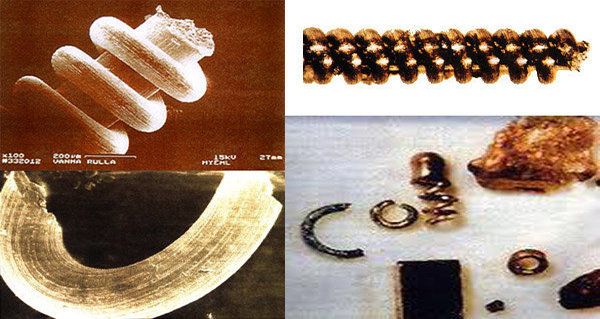A prehistoric object discovered in a rare or unlikely setting is known as an out of place artifact (oopart). Ooparts are artifacts produced with technology that is too advanced for the level of society associated with the period in which they were discovered.
Many people see ooparts as proof that popular science intentionally or unintentionally ignores important areas of information.

In 1991, geologists conducting geological surveys along the banks of many Russian rivers found hundreds of tiny coil-shaped objects, some as small as 1/10,000th of an inch in diameter.
The researchers were conducting mineralogical studies in the Ural Mountains in preparation for prospecting, so you can imagine their surprise at the discovery.
They were discovered at depths ranging from 10 to 40 feet (3-12 meters) and are estimated to be between 20,000 and 318,000 years old.
The biggest are 1.18 inches (3 centimeters) long, while the tiniest are just 2.5 microns in length. The average strand of hair is around 100 microns length, for comparison. Copper is used for the larger coils, while tungsten or molybdenum is used for the smaller ones.

Their form indicates that they are not naturally occurring metal particles, but rather advanced nanotechnology components.
These ooparts have ignited a raging debate that is still going on today. The enigmatic microscopic structures are 300,000 years old, according to scientists. Is it possible that Earth had a technologically advanced civilization at the time, or are these objects evidence of another intelligence centered on our planet?
Owing to various and well-known constraints, our modern society has only recently evolved nanotechnology. For humans who lived 300 years ago, mainstream science does not recognize a technical degree beyond the occasional use of fire.
Scientists haven’t been able to figure out who or what created these structures, but one thing is certain: they aren’t normal, as no established mechanism can create them.
While some have claimed that these tiny structures are simply debris from nearby Plesetsk space station test rockets, a study from the Moscow Institute determined that they are much too old to have come from recent manufacturing.
Dr. E.W. Matvejeva of Moscow’s Central Scientific Research Department of Geology and Precious Metals Exploitation writes in 1996 that the elements, while being thousands of years old, are of technical origin.
The arguments that the coil-shaped artifacts are made and still very old have been backed up by facilities from Helsinki and St. Petersburg.
Four separate facilities in Helsinki, St. Petersburg, and Moscow have researched the objects. However, with the death of Dr. Johannes Fiebag, the find’s principal researcher, in 1999, further study into these tiny structures appears to have come to an end.
This discovery raises a lot of concerns. Was it possible for humans to master nanotechnology during the Pleistocene epoch? Who could have learned such advanced industrial technology during the time of Homo erectus? Is this evidence of a long-lost culture on Earth, or are these objects left behind from alien visitors?
We can never find out.






